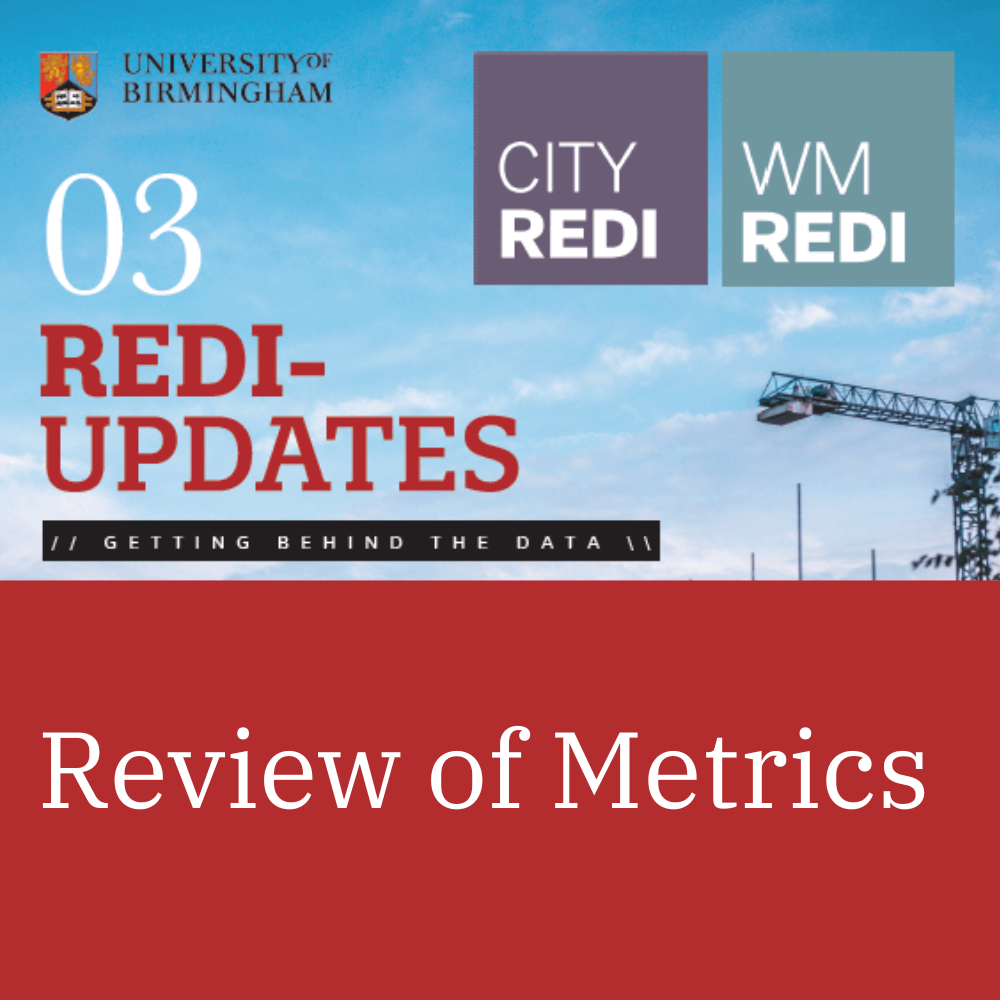
Welcome to REDI-Updates. REDI-Updates aims to get behind the data and translate it into understandable terms. In this edition, WMREDI staff look at the government's flagship policy - Levelling Up. We look at the challenge of implementing, understanding and measuring levelling up. Josh Swan maps the most appropriate metrics from our City Index dashboard to the Levelling Up missions from the White Paper. In this blog, we will examine each metric and why it is useful in the goal of measuring places on their levelling up progress. View REDI-Updates.
Mission 1- Living Standards
Gross Domestic Household Income per Head (GDHI per Head)
The ONS measure of GDHI per Head illustrates the level of disposable income left after deductions such as taxation, social contributions, and benefits. This measure is preferred over measuring the wealth of an area with measures such as Gross Value Added (a measure of the total value created in an area). GDHI per Head helps us understand the purchasing power of households in the area, and how it compares to the national average. Paired with a cost-of-living measure, this could show how comfortable people are according to living standards. If setting a level for GDHI we have to understand what the combination of both the income and price levels are for a place, this would allow us to see if the relative affordability for people, levelling up should be about people being able to live well in the place they are.
% of LSOAs (Lower Layer Super Output Area) in most deprived 10% nationally
Measuring household income and skills are just part of the picture, but if a local area is recognised as deprived, it is not fulfilling its true potential and requires the attention of investors to help level up. This measure highlights the living standards and the multiple types of deprivation that contribute to poorer life chances. However, this is a moving target and there will always be a bottom 10%. This raises the question of the absolute level that all places should be striving to achieve in modern society.
GVA per hour
Productivity is recognised as measuring the potential of an area in terms of generating value for the economy. Not all areas perform equally, as some areas with high-value service sectors will greatly outperform rural agricultural farmland in total GVA. However, recognising what the rate of wealth is by each hour worked will help identify if a region is lagging in production capability. Ideally, the gap would narrow between those places at the top and bottom and that would be the target; however, as noted the differences are often due to sectoral mix and diversity in the business base which can help to improve resilience to shocks
Percentage of jobs below the living wage
Of all the metrics on the City Index, none are as good a fit with levelling up as the percentage of jobs below the living wage. Here we have a benchmark that clearly defines the line to reach and one that changes each year to reflect living costs, inflation, and legislation around minimum wage. Therefore, it is appropriate to include this as a possible measure of levelling up – the greater the percentage of jobs above the living wage, the greater the productivity, wealth, and success of that area.

Unemployment rate 16-64
A metric from the ONS Annual Population Survey includes questions about economic activity and qualifications. The unemployment rate can be used to assess how much ‘slack’ there is in the economy. Low unemployment restricts businesses’ ability to fill jobs, as we see in the economy at the moment. High unemployment is also a problem as it affects people’s standard of living, well-being and crime. Every economy has to adjust to labour market shocks and lagged adjustments; currently, the global economy is going through one of the biggest shocks we have seen. There is, however, a debate on what the natural rate of unemployment is, and since the 1990s this stood at about 4.5% to 5.5% globally but this has been reducing and we have seen considerable tightening causing major employment problems. The challenges posed by tight and slack labour markets need to be borne in mind when interpreting local unemployment rates.
Mission 3- Transport Infrastructure
Total highways and transport services
This metric measures the expenditure of local authorities regarding road infrastructure and public transport. Whilst spending needs to take account of each authority’s needs, budget and lending, it is nonetheless an indication of what investment is going into local transport infrastructure. The optimum level may change by place as it needs to reflect the population and the accessibility needs, more rural areas generally need high spending to ensure accessibility.

Mission 4- Digital Connectivity
4G outside coverage from the 4 main providers
Using data from OFCOM, we can determine the extent of 4G coverage from the four main phone providers, i.e. O2, EE, Vodaphone and 3. The metric is a percentage of coverage in the local authority, something in which more rural set cities are more likely to have less coverage than the larger metropolitan cities. This would need a level which looks at the minimum acceptable service, however, this will change as technology improves.
Median download (Mbps)
Each local authority has a median download speed for its fixed addresses. Given that internet connectivity is essential for living in the modern world, internet speeds determine how communities interact and how effectively businesses and ordinary people can do their jobs. This is an important metric for evaluating the digital infrastructure of an area. Again, the level will change as technology changes.
Mission 5- Education
School readiness: % of children achieving a good level of development at the end of Reception
Measuring the level of skills is a key component of levelling up. It is important to measure this at an early stage in the form of school readiness. Education is a crucial long-term policy that the government holds to be able to prepare future generations. Alignment with the measures already in place nationally and agreed performance levels is crucial here to avoid conflicting measures.

Mission 6- Skills
% above NVQ level 1
By measuring a proportion of those above NVQ level 2 (having at least 5 GCSEs A* – C or 4 to 9) in a local authority, we can determine how much of the population has fundamental skills such as English and Mathematics. As mentioned before, upskilling the population is essential to closing the poverty and income gap and providing a better-skilled workforce to firms. This relates to mission 6 as it mentions training for ‘the lowest skilled areas’. Again this is difficult to put an ideal level as an older population may have fewer qualifications yet still be highly skilled due to experience but lack certification, therefore the population composition has a significant effect. However, at a local level places may want to set a target based on improving their past performance and against similar areas.
% above NVQ level 4
This level of NVQ looks at higher education qualifications. Mission 6 mentions ‘high-quality skills training’ which this metric identifies more closely. Places that have Higher Education Institutes, good quality jobs and housing have a significant advantage in improving on this indicator; (it is linked to employment and housing quality). Any target set to level up will therefore be highly dependent on the local circumstances and what is achievable. This is also a longer-term indicator given the time it takes to improve an individual’s skills to this level.
Mission 7- Health
Life expectancy at birth and 65+ by males and females
Life expectancy is a clear indication of the health of a population and is often associated with better quality of life. Life expectancy between regions can highlight health concerns, pollution levels, the extent of demerit goods, such as tobacco products, in society and the quality of local facilities. Life expectancy is the result of decades of interconnected effects on people’s lives, as well as the movement of people as they age, which can lead to some areas having a greater density of older people and more illnesses. Levelling up should aim at improving those places with low levels of life expectancy and lifting them up (similar to deprivation).

Mission 8- Wellbeing
Number of Suicides, Anxiety, Happiness, Worthwhileness, Life-satisfaction
An emerging consensus when looking at levelling up is that the general welfare of the population, health and wealth is critical. Quite simply, if people are feeling unhappy or unfulfilled in life then this is a potential sign of wider socio-economic malaise. In particular, suicide statistics point to other variables such as unemployment levels, quality of life and available facilities/services near individuals. If a population is unhappier and less satisfied than other areas, then local pride in the area will also be lowered. Wellbeing is a highly complex issue affected by all the other issues covered in the indicators, so again aiming to reduce the negative impacts across the board is essential.
Mission 10- Housing
House price to income ratios
This measure is crucial in understanding the biggest cost faced by many English households. It also helps determine barriers to homeownership which could trap people in a rent cycle (especially the younger generation). Although incomes tend to be higher in the Greater South East than elsewhere, so too are house prices, such that house prices may be more affordable in areas characterised by poorer economic performance. Hence, the spatial patterns on this measure are rather different to those for many of the others outlined above.

Mission 11- Crime
First-time offenders
Crime is extensively linked to deprivation and poor socioeconomics. If the rate of crime is higher in one area compared to others, then it is a sign that there may be deep structural problems. It must be noted that comparison against rural areas to cities where rural areas will almost always have lower crime rates, so this metric needs to be carefully considered within the setting of the area. Measuring first-time offenders enable us to track the flow into criminality in an area, at the local level recidivism may be an issue and therefore also tracking reoffending may be necessary.
Children in the youth justice system
This metric is useful for indicating if there is a lack of opportunities for young people in their local areas. Like the previous metric, the high youth crime in an area could indicate poor socioeconomic conditions, poverty and poor education and training opportunities. Also, high levels of children in social care feed through to crime levels later and this again is a long-term structural issue to tackle holistically
Missing Metrics in the City Index
There are three mission statements that cannot be addressed by the City Index. For mission 2 regarding Research & Development (R&D), the data that the white paper lays out has a regional focus instead of a city or local authority level. Similarly, mission 9, pride in place, looks to have an emphasis on green spaces and high-street rejuvenation. Whilst the ONS have data on green spaces at the local authority level that could be included as a measure, WMREDI and the WMCA carried out local modelling on the future of Birmingham City Centre and the possible scenarios that could befall the local high street, however, this cannot be done without building tools and data to examine small geographies. We are unable to recreate this data at the level of geography that the city index investigates (Local Authority), currently nowhere can be without detailed research and data collection (which reduces the ability to benchmark). Finally, mission 12 is too vague and unclear to be able to attach any meaningful data to measuring whether a place desires more local power.
Using the proposed metrics, we can analyse the performance of cities across the UK in how they are faring in their levelling up goals. Whilst the city index cannot be used for every area of levelling up (mainly data that does not go down to the local authority level) it nevertheless is useful to policymakers to be able to see how their place is compared, and identify what policy domains could be worked on to make each place a more prosperous and productive to make residents prouder of the place they reside in.
In terms of levelling up, the level needs to be set based on what is appropriate within a geography. Targets need to be linked to devolved powers, budgets and the levers places have in order to make a difference at the level.
This blog was written by Josh Swan, City-REDI / WMREDI, University of Birmingham.
Disclaimer:
The views expressed in this analysis post are those of the authors and not necessarily those of City-REDI, WMREDI or the University of Birmingham.
